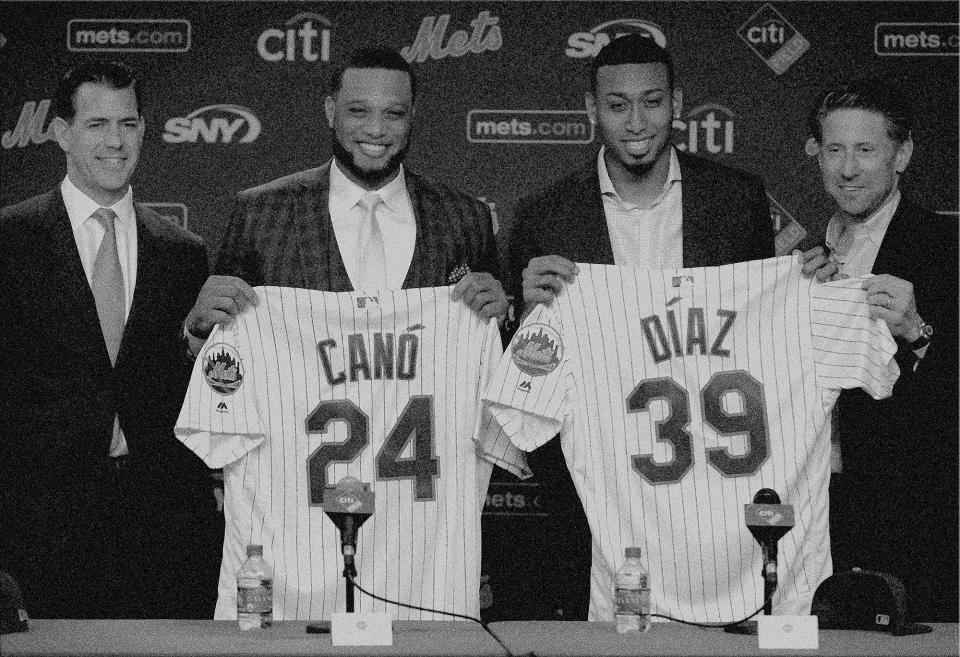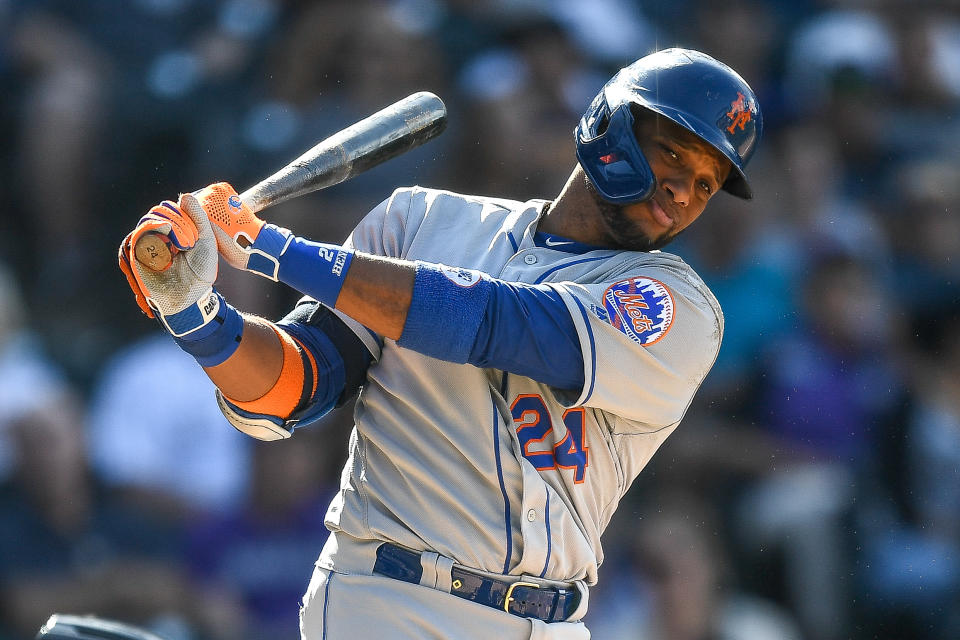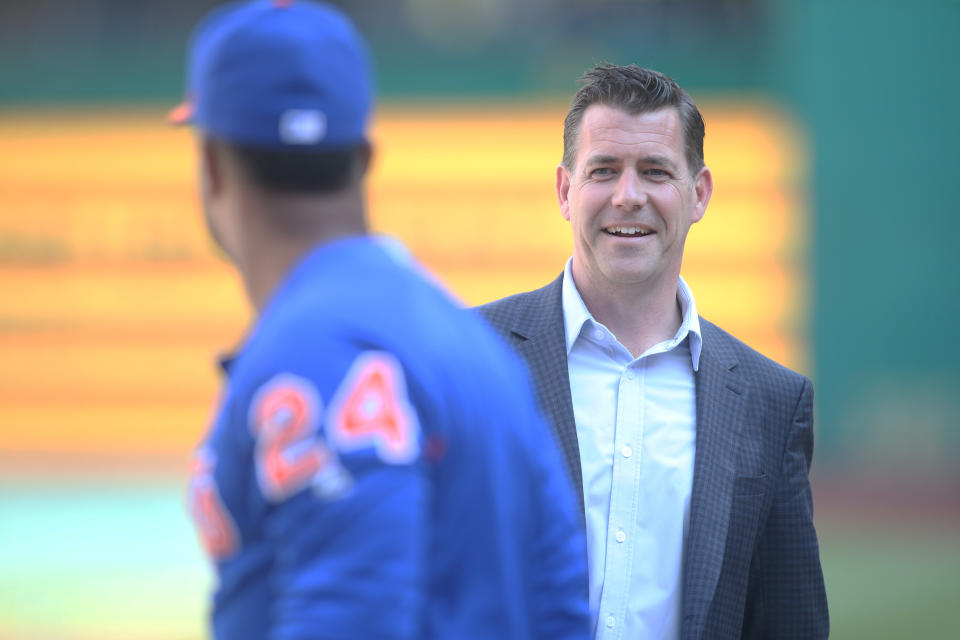What if the Mets had not traded for Robinson Cano and Edwin Diaz?
NEW YORK – A certain sense of accomplishment and bravado filled the press conference room at Citi Field on Dec. 4 as Edwin Diaz and Robinson Cano were introduced as the newest members of the New York Mets.
The offseason is a time for hope and optimism, and on that December day, Mets officials believed they had just made a move that would lead them to 90 wins. One only had to look at the Cheshire cat grins in the room to know that they felt they had just become contenders.
In their eyes, after two down years, the Mets were back.
“Robinson Cano is one of the best second basemen in the history of the game. He immediately will impact the middle of our lineup and increase the run production in a meaningful and significant way,” newly hired Mets general manager Brodie Van Wagenen said during that introductory press conference. “Edwin is the best closer in the game today. He will the anchor of our bullpen and electrify our fan base. Most important, everyone should know that these two players are here to help us accomplish our goals of winning now and in the future.”
Nine months later, almost everything Van Wagenen said did not come to pass.
Cano looked like a shell of himself for most of the year, struggling to stay on the field in the second half. Diaz transformed from a lockdown closer into a gopher-ball machine who some think may not be fit to handle New York.
That trade sent five players to Seattle: outfielder Jay Bruce, relievers Anthony Swarzak and Gerson Bautista and prospects Jarred Kelenic and Justin Dunn. And in less than a year, it’s already considered one of the worst in franchise history, up there with the deals that sent Tom Seaver and Nolan Ryan out of town.
Those did not help the Mets win now with the team being eliminated from the playoffs race Wednesday. And their salaries and production could hurt the Mets’ chances to win in the future, as Van Wagenen is fond of saying.
Considering the Mets’ window to contend is open for maybe two more years, it raises the question: How much better of a position would the Mets be in entering this offseason had they not made that fateful trade?
“They mortgaged the future for Cano and Diaz,” one league source said.

What if the Mets hadn’t made the trade?
The Mets hired Van Wagenen in part because he told the Wilpon family what they wanted to hear: He did not see a need for a rebuild. He figured they could win now.
“I believe this team needs to build, not rebuild,” Van Wagenen said after being hired.
That’s why Cano and Diaz arrived along with Wilson Ramos, Jed Lowrie, Jeurys Familia and Justin Wilson, among others. Prospects were traded by the boatloads. The Mets were concerned with winning now and would worry about the future later.
For the sake of examining where the Mets would be had they not made that trade, we can allow the Mets to still make some win-now moves, but the one exception will be that Van Wagenen does not acquire Cano and Diaz.
Van Wagenen, as a first-year general manager, would instead decide to take a year to see to see what he had to work with. He keeps his top-tier prospects, makes some signings to fill holes, but does nothing to affect his term’s long-term future.
New York fans are a smart bunch. They would have been willing to buy into a plan that allowed for a year of analyzing the system and then reacting accordingly.
In this world, the Mets can still add Ramos, Wilson, Lowrie and Familia, although the latter two have been disastrous additions. They still acquire J.D. Davis since he’s a young player on the rise, but pass on adding Keon Broxton.
The Mets also commit to playing their youngsters, giving Pete Alonso the starting job at first base and starting 2018 sensation Jeff McNeil at second base.
The payroll remains roughly the same since the Mets still have Jay Bruce and Anthony Swarzak for $22.5 million Bruce and Swarzak have combined for a 0.7 WAR, according to Baseball Reference, compared to -0.1 for Cano and Diaz.
Since they’re not in full win-now mode, the Mets also pass on adding Marcus Stroman at the trade deadline. This allows them to keep two of their better prospects in pitchers Anthony Kay and Simeon Woods-Richardson.
This version of the Mets would win fewer games than the 80-plus games the Mets will win this year, but a few wins are irrelevant when neither season results in a postseason berth. And considering how well the Mets have drafted in recent years, they would benefit from having a better draft pick than they are set to have.
In this alternate universe, the Mets enter the offseason in a much better position.
They know that Alonso, McNeil and Davis are legitimate, and they still have a treasure chest of prospects to go along with financial flexibility. An offensive core is here that can finally complement the team’s starting pitching.
In retaining Kelenic, Kay, Woods-Richardson, and Justin Dunn, the Mets have a loaded farm system with top-100 prospects at their disposal. They can either use some of the prospects to help in 2020 or to help fill pitching needs.
The Mets would be in a much better spot to trade Kelenic in this scenario since they would be better suited for a title pursuit than they were when they acquired Cano and Diaz. That’s a move that a team close to a title makes.
A source said that Van Wagenen is well aware that Kelenic may be a stud in the near future, but he prioritized winning now over several years down the line. Van Wagenen declined comment for this story.
Mets COO Jeff Wilpon said of trading Kelenic: “It’s (the front office) being comfortable ... and saying, ‘we realize this is a potential star, but he’s 3-4 years away, and if we’re going to win now, we’re going to do some things now that might hurt you a little bit down the line, but we’ll have room to fill that in at a later time.’”
Another critical improvement: The Mets’ books would not be locked into Cano and Diaz for roughly $25-$35 million for the next three-plus years. Cano is earning $20 million over the next four seasons while Diaz enters the first year of arbitration this winter. Despite a down year, Diaz will be rewarded for saves in arbitration.
That financial wiggle room would allow them to be players for top free agents such as Anthony Rendon, who would fit perfectly as the third baseman.
It would also be easier to retain Zack Wheeler, a free agent to be, and the Mets could slot Anthony Kay into the fifth spot in their rotation. The Mets could also use that extra cash to add a reliever who can complement Lugo and Wilson.
There would be some fear around the league of a Mets team that has the financial leeway to make big moves while being armed with a deep farm system.
As of now, the Mets have neither while needing to make up ground.

Robbie Cano, where’d ya go?
Cano doesn’t beat around the bushes when describing his season.
“It’s not the way I was expecting (it to go),” Cano told Yahoo Sports.
Cano is slashing .261/.310/.436/.746 with just 13 homers, and has landed on the injured list three times. The Citi Field faithful have booed him at times.
For the first time, there are folks writing off Cano, once one of the most feared hitters in the majors. He’s now the second-best second baseman on his team.
But Cano still believes he can be Robinson Cano of yesteryear.
“Of course. For sure, yeah,” said Cano, who cost the Mets five runs defensively per Fangraphs. “If you look at Statcast, I’ve probably been hitting the ball the same I have the last five years. You see the results when I’m healthy. I was able to do my job and play at a high level. Go home, work hard and prepare for next year.”
Cano has often said he doesn’t want to make excuses, but he’s made it clear that he believes being hit on his hands three times is a main factor for his struggles.
He posted a .646 OPS in the first half while dealing with the aftermath of those blows to his hands compared to a .916 in the second half.
The hand issues, though, have nothing to do with the lower-half injuries, a troubling sign for a 36-year-old. He pulled his left quad twice, and his left hamstring once.
Excluding last year’s suspension-shortened season, Cano will play in the fewest games of his career this year. He’s now a $20 million injury liability.
“Just a year, one of those years, we’re human, we’re not perfect,” Cano said. “I would say I was blessed to play 11 straight years without hitting the DL all year. It’s one of those years. Get your legs stronger, and keep working hard, and that’s what I’m going to do. It’s a year that sometimes happens to guys.”

From elite closer to mop-up man
Any list of worst moments of the season features Diaz on the mound.
His implosion in Los Angeles. His collapse in Philadelphia. The meltdown against the Nationals earlier this month.
Brought in to be Mariano Rivera, Diaz instead imitated Armando Benitez.
“Season of highs and lows,” Diaz said through team translator Alan Suriel.
Diaz’s season featured many more lows than highs, and his regression clouds his future outlook. He can’t be counted on in the late innings again until he proves himself, and there’s no guarantee he will ever be a lockdown closer again.
The odds are Diaz is not as good as he was in Seattle and not as bad as he has been in New York, but there are now questions if he can handle New York.
The stuff is still good, showcased by his 97 strikeouts in 56.1 innings. Diaz simply allowed too many homers and offered too many passes.
The Mets could look to trade him again or hope that perhaps a new ball will help Diaz. The Mets were open to moving Diaz in July but set a high price per sources, including a request of Andrew Benintendi from the Boston Red Sox.
Acquired to stabilize the bullpen, Diaz instead is perhaps the player most responsible for why the Mets missed the playoffs for a third straight year.
“I came here after having three excellent seasons in Seattle,” Diaz said.”I’m not going to come here thinking I’m one of the worst because I have been the best and just because of a season ups and downs doesn’t mean it will determine the rest of my career. ...Work in the offseason on being the best I can be.”

Navigating within a window that is closing
Before the season opened, WFAN host Maggie Gray posed a simple question to Van Wagenen: If the Mets miss the playoffs but are relevant in September, is the season a success?
“Not for me,” Van Wagenen said.
By Van Wagenen’s standards, that means this season is not a success, largely due to his trade that backfired and could haunt this franchise for years to come.
Kelenic, ranked the 14th-best prospect by MLB.com, appears to be a star in the making, and could replace Michael Conforto should he leave after the 2021 season. It’s possible Kelenic and Conforto could be teammates in Seattle, not New York.
In trading Kay, Dunn and Woods-Richardson, the Mets lack rotational depth.
The Mets are set to receive 154 starts from their core starters this season, but that type of health can’t be taken as a given. Considering the team’s other holes, a fifth starter —assuming Wheeler leaves —should also be on the back burner.
The bullpen is still a mess even if Diaz returns, and could be in even worse shape if Seth Lugo moves into the rotation. They will have to bolster that unit on a budget, and acquiring strong relievers is costly. Trying to add quality relief help in the discount department is quite tough considering the volatility of relievers.
Cano will man second base again while making $20 million, and try to show he is not losing a battle with father time in his age-37 season.
His presence will keep Rendon and other elite free agents from coming to Queens.
The clock is ticking on the Mets to receive any value from this trade that seems like it’s one that will be regretted for years to come.
“I would love to have that healthy season and help this team,” Cano said. “I want to help this team, beyond individual numbers, to go out and make the playoffs.”
More from Yahoo Sports:

